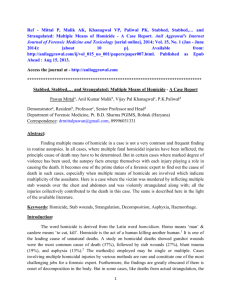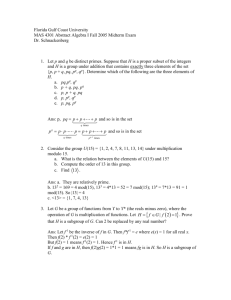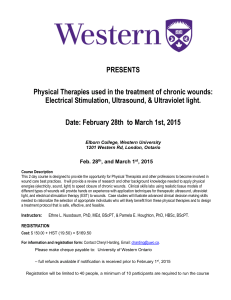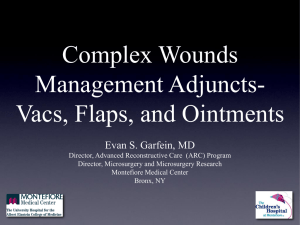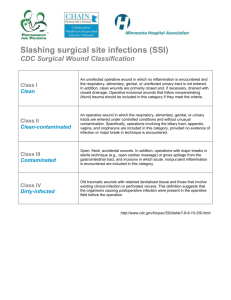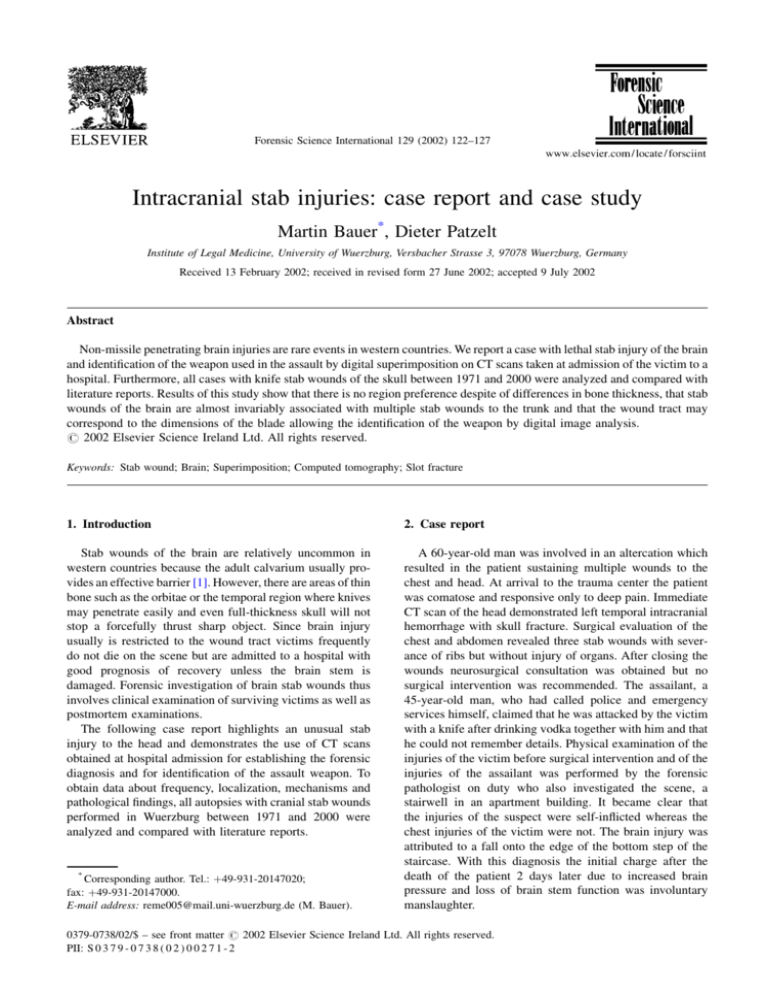
Forensic Science International 129 (2002) 122–127
Intracranial stab injuries: case report and case study
Martin Bauer*, Dieter Patzelt
Institute of Legal Medicine, University of Wuerzburg, Versbacher Strasse 3, 97078 Wuerzburg, Germany
Received 13 February 2002; received in revised form 27 June 2002; accepted 9 July 2002
Abstract
Non-missile penetrating brain injuries are rare events in western countries. We report a case with lethal stab injury of the brain
and identification of the weapon used in the assault by digital superimposition on CT scans taken at admission of the victim to a
hospital. Furthermore, all cases with knife stab wounds of the skull between 1971 and 2000 were analyzed and compared with
literature reports. Results of this study show that there is no region preference despite of differences in bone thickness, that stab
wounds of the brain are almost invariably associated with multiple stab wounds to the trunk and that the wound tract may
correspond to the dimensions of the blade allowing the identification of the weapon by digital image analysis.
# 2002 Elsevier Science Ireland Ltd. All rights reserved.
Keywords: Stab wound; Brain; Superimposition; Computed tomography; Slot fracture
1. Introduction
2. Case report
Stab wounds of the brain are relatively uncommon in
western countries because the adult calvarium usually provides an effective barrier [1]. However, there are areas of thin
bone such as the orbitae or the temporal region where knives
may penetrate easily and even full-thickness skull will not
stop a forcefully thrust sharp object. Since brain injury
usually is restricted to the wound tract victims frequently
do not die on the scene but are admitted to a hospital with
good prognosis of recovery unless the brain stem is
damaged. Forensic investigation of brain stab wounds thus
involves clinical examination of surviving victims as well as
postmortem examinations.
The following case report highlights an unusual stab
injury to the head and demonstrates the use of CT scans
obtained at hospital admission for establishing the forensic
diagnosis and for identification of the assault weapon. To
obtain data about frequency, localization, mechanisms and
pathological findings, all autopsies with cranial stab wounds
performed in Wuerzburg between 1971 and 2000 were
analyzed and compared with literature reports.
A 60-year-old man was involved in an altercation which
resulted in the patient sustaining multiple wounds to the
chest and head. At arrival to the trauma center the patient
was comatose and responsive only to deep pain. Immediate
CT scan of the head demonstrated left temporal intracranial
hemorrhage with skull fracture. Surgical evaluation of the
chest and abdomen revealed three stab wounds with severance of ribs but without injury of organs. After closing the
wounds neurosurgical consultation was obtained but no
surgical intervention was recommended. The assailant, a
45-year-old man, who had called police and emergency
services himself, claimed that he was attacked by the victim
with a knife after drinking vodka together with him and that
he could not remember details. Physical examination of the
injuries of the victim before surgical intervention and of the
injuries of the assailant was performed by the forensic
pathologist on duty who also investigated the scene, a
stairwell in an apartment building. It became clear that
the injuries of the suspect were self-inflicted whereas the
chest injuries of the victim were not. The brain injury was
attributed to a fall onto the edge of the bottom step of the
staircase. With this diagnosis the initial charge after the
death of the patient 2 days later due to increased brain
pressure and loss of brain stem function was involuntary
manslaughter.
*
Corresponding author. Tel.: þ49-931-20147020;
fax: þ49-931-20147000.
E-mail address: reme005@mail.uni-wuerzburg.de (M. Bauer).
0379-0738/02/$ – see front matter # 2002 Elsevier Science Ireland Ltd. All rights reserved.
PII: S 0 3 7 9 - 0 7 3 8 ( 0 2 ) 0 0 2 7 1 - 2
M. Bauer, D. Patzelt / Forensic Science International 129 (2002) 122–127
Autopsy which was performed 3 days after death revealed
a stab wound to the head as cause of the intracranial
hemorrhage with slot fracture of the temporal bone and
hemorrhagic wound tract through the temporal lobe and the
cerebellum (Figs. 1 and 2). With this diagnosis the case had
123
to be considered as homicide. The apartment of the assailant
and the surroundings of the scene were searched for the
weapon and numerous knives were brought in. Re-evaluation of the CT scans showed a well circumscribed wound
tract obviously corresponding to the form of a knife blade.
Fig. 1. Lateral view of the skull with slot fracture in the temporal bone.
Fig. 2. Non-contrasted CT scan showing hemorrhagic wound tract in the left temporal lobe with air inclusions and diffuse brain swelling.
124
M. Bauer, D. Patzelt / Forensic Science International 129 (2002) 122–127
Fig. 3. Same CT scan as in Fig. 2. A digital image of the weapon used in the assault was superimposed to show correspondence of the wound
tract with the dimensions of the blade.
Fig. 4. Bone window of the CT scan shown in Fig. 3 with superimposed weapon. The depth of insertion corresponds to the width of the slot
fracture.
M. Bauer, D. Patzelt / Forensic Science International 129 (2002) 122–127
Digital images were taken of the knives and superimposed
on the CT scans after adjusting the angle of the blade to that
of the CT images as calculated from the scout image (Figs. 3
and 4).
After identifying a suitable knife DNA from the victim
was detected on the blade near the guard although this knife
had been thoroughly cleaned in a dishwasher.
125
(n ¼ 1). The regions involved were temporal (n ¼ 4), frontal
(n ¼ 4), transorbital (n ¼ 3), occipital (n ¼ 4) and parietal
(n ¼ 2). The victims were males in seven cases, females in
six cases, the assailants exclusively males. The motive of the
assaults was rape (four cases), domestic quarrels (two cases)
or private altercations between friends or colleagues. In
these cases alcohol intoxication and/or a psychiatric disorder
played a major role for the motivation of the assailant.
3. Case study
4. Discussion
Autopsies performed in the Institute of Legal Medicine,
University of Wuerzburg, during the period 1971–2000
(n ¼ 9487) were reviewed retrospectively. In 503 consecutive homicides and 175 cases with lethal stabbing injuries, 13
intracranial stab wounds (7.4% of all stab injuries, 0.14% of
all autopsies) were found (Table 1). From these 13 cases, 6
cases showed non-lethal and 4 cases lethal brain injuries, 3
cases involved only penetration of the skull without injury to
the brain parenchyma. Twelve cases were associated with
multiple stab wounds to the chest, neck and/or abdomen or
other injuries. The causes of death in the nine cases without
lethal brain injury were hypovolemic shock due to heart or
vessel penetration (n ¼ 8) or blunt injury to the head
Penetrating craniocerebral knife injuries are rare in western countries and occur almost exclusively in homicides. In
our data only 13 cases were documented in 30 years. Even
less frequent are lethal stab injuries of the brain with only
four cases in this time period. In Brooklyn, New York, 3 such
cases occurred in 1508 homicides from 1963 to 1968 [2], in
Essen, Germany, 8 homicides with stab wounds to the skull
among 3545 autopsies and 118 cases with stab injuries were
observed between 1973 and 1984 [3]. Among 151 patients
with external wounds of the head after a stabbing assault
treated in a Level I trauma center in Washington, DC, over a
10-year-period only six had intracranial injuries [4]. Studies
Table 1
Listing of cases with intracranial stab wounds examined in Wuerzburg between 1971 and 2000
Case
Age/sex
Site of
skull penetration
Additional injuries
Assault motive
Assailant
Brain injury:
present/cause of death
1
31/m
Frontal
Private
Psychiatric disorder
Yes/no
2
29/m
Temporal
Private
Alcohol influence,
1.5 g/kg
Yes/no
3
63/m
Transorbital
Private
Psychiatric disorder
Yes/no
4
51/f
Frontal
Rape
22/f
Occipital
Rape
Alcohol influence,
2.1 g/kg
Psychiatric disorder
No
5
No
6
41/f
Occipital
Rape
Not known
No
7
14/f
Rape
Not known
Yes/yes
8
40/m
Temporo-parietooccipital
Transorbital
Private
Alcohol influence
Yes/no
9
66/f
Parieto-occipital
Multiple stab wounds to
the chest/neck
Blunt injury to the
head, multiple stab wounds
to the chest/abdomen
Multiple stab wounds to
the chest/neck
Multiple stab wounds to
the chest/neck
Multiple stab wounds
to the chest/neck
Multiple stab wounds
to the chest/neck
Multiple stab wounds
to the chest/neck
Multiple stab wounds
to the chest
Strangulation
Domestic
Yes/yes
10
53/m
Transorbital
Killed himself with
hand grenade, alcohol
influence
Alcohol influence
11
12
49/m
58/f
Fronto-temporal
Frontal
13
60/m
Temporal
Multiple stab wounds
to the chest
None
Multiple stab wounds
to the chest
Multiple stab wounds
to the chest/abdomen
Private
Not known
Domestic
Private
Not known
Alcohol influence,
2.4 g/dl
Alcohol influence,
1.8 g/dl
Yes/yes
Yes/yes
Yes/no
Yes/yes
126
M. Bauer, D. Patzelt / Forensic Science International 129 (2002) 122–127
with incredible case numbers (up to 597 patients in 12 years)
are reported from South Africa [5,6] where transcranial stab
injuries remain a frequent cause of emergent neurosurgical
intervention. Whereas in these studies only 10% of the
patients had stab wounds to regions other than the head
[7], in our series all cases except one were associated with
multiple stab wounds to the trunk. This probably reflects
differences in violent behavior: the patients in South Africa
are predominantly young males involved in fights [8,9], in
our data comparable fight situations did not occur. Assault
motives were rape, domestic quarrels or private altercations
between friends or colleagues. In the latter cases, the assailants almost invariably were under significant alcoholic
influence or suffered from a psychiatric disorder.
In suicides perforation of the skull is rare and selfinflicted stab injuries of the brain were not yet reported
[10]. Interestingly, although 14% of all assailants using a
knife were females, none of them stabbed the head. This
seems to be a male-specific kind of violence potentially
related with the force assumed to be necessary for penetrating the skull. Indeed this force is believed to be about 5
higher in the temporal region (255 N) and 11 higher in the
parietal region (540 N) [11] than the force needed to perforate the skin (49 N) [12], but well within the range of up to
1000–2000 N postulated to be seen during impact on targets
in experimental knife attacks [13,14]. Therefore, intracranial
knife penetration can be expected to occur if the blade is
sharp and rigid, the force created by the assailant high and
the head of the victim fixed. We believe that the low number
of skull penetrations by sharp force is not directly related to
the alleged barrier function of the skull or to the enhanced
resistance of bone but rather to the fact that stab attacks in
western countries are only rarely directed to the head but
more frequently to more vulnerable regions such as the neck,
heart or abdomen. Another reason might be that penetration
of the skull is more readily achieved when the head of the
victim is fixed and when the physical activity of the victim is
reduced or totally lost. In all but one cases presented here
there were extracranial injuries that could explain rapid
incapacitation. The force necessary for skull penetration
which has to be created by muscular work of the assailant
because the mass of the weapon (knife) is negligibly small,
requires to be thrust onto a very small surface area. Any
movement of the skull relative to the stab direction would
probably prevent skull penetration and cause the knife to be
deflected. However, fixation of the head is not a conditio sine
qua non if the impact force is high enough. There are case
reports with witnessed attacks to the non-fixed head with
severe intracranial penetration [15].
According to the literature most stab wounds of the brain
occur through the orbita or the temporal region [16]. This
hypothesis sounds plausible because of the thinness of the
bone in these areas but it is not supported by the available
data. The sites of scalp and skull penetration appear to be
evenly distributed with a majority of wounds in the parietal
(40%) and frontal (21%) region in the South African data [7]
and no significant region preference in our cases (Table 1).
This supports the assumption that the difference in bone
thickness is not the most important parameter for effective
intracranial penetration in knife attacks and that under
suitable conditions as discussed above a knife attack to
the head will penetrate the skull regardless of the site of
injury.
Postmortem diagnosis of intracranial stab injury is easy to
establish if a characteristic slot fracture is present. The
blood-filled wound slit created by a stab wound is largely
restricted to the wound tract and corresponds to the dimensions of the penetrating object. This may be identified from
CT scans using digital image superimposition because the
insertion of the knife will be stopped by the cranium which
cannot be indented such as the abdominal and chest wall and
which prevents twisting or rotating of the knife. This is
especially true in stab wounds to the temporal fossa in which
the blade after penetrating the skull usually slides through
the temporal lobe parallel to the floor of the middle fossa
because a steep entrance angle would cause the blade to be
driven into the petrous ridge or adjacent bone structures
[8,17]. The hemorrhagic wound tract therefore is directly
projected onto the axial CT sections and the dimensions of
the penetrating object can under optimal conditions be
measured directly from the CT image considering the angulation of the blade and of the CT. In our case, the murder
weapon initially was missing but a great number of knives
was seized in the apartment of the assailant and around the
scene so that each one could be measured and compared with
the wound tract. The weapon with the best match eventually
was confirmed to have caused the brain injury by DNA
analysis although, it had been thoroughly cleaned in a
dishwasher.
5. Conclusion
This case demonstrates that stab injuries of the brain
provide the opportunity of exactly correlating the wound
tract with the weapon used in killing in contrast to stab
wounds of the trunk where due to the elastic properties of
skin and organ tissues and to the variable relative position of
the organs only limited information about the characteristics
of the knife used is available. Since secondary bleedings and
autopsy artifacts might interfere with exact identification of
the wound tract, postmortem CT scans in cases with immediate death on the scene should be obtained when possible. In
surviving victims the use of CT scans taken immediately
after admission is recommended. If no CT images are
available, the brain slices should correspond to the plane
of the wound tract which, however will be difficult to achieve
in most cases.
The case study and the literature review presented here
show that although, the force needed to penetrate the skull is
considerably higher than the force necessary for penetrating
the skin a forcefully performed attack with a sharp and rigid
M. Bauer, D. Patzelt / Forensic Science International 129 (2002) 122–127
knife will perforate the cranium regardless of the anatomical
site. In contrast to South Africa where the head frequently is
the only target for knife attacks in fights between young
males, in western countries knife assaults are predominantly
directed to the trunk with stab injuries of the head occurring
in situations with exacerbating violence frequently due to
alcohol intoxication or psychiatric disorder.
[10]
References
[11]
[1] L.C. Dempsey, D.P. Winestock, J.T. Hoff, Stab wounds of the
brain, West. J. Med. 126 (1977) 1–4.
[2] V.J.M. Di Maio, D.J. Di Maio, An unsuspected stab wound of
the brain: case report, Mil. Med. 137 (1972) 434–435.
[3] C. Ritter, G. Adebahr, Stab wounds of skull and brain, Z.
Rechtsmed. 96 (1986) 229–234.
[4] S. Deb, J. Acosta, A. Bridgeman, D. Wang, S. Kennedy, P.
Rhee, Stab wounds to the head with intracranial penetration,
J. Trauma 48 (2000) 1159–1162.
[5] N. Nathoo, H. Boodhoo, S.S. Nadvi, S.R. Naidoo, E. Gouws,
Transcranial brainstem injuries: a retrospective analysis of 17
patients, Neurosurgery 47 (2000) 1117–1122.
[6] N. Nathoo, S.S. Nadvi, Traumatic intracranial aneurysms
following penetrating stab wounds to the head: two unusual
cases and review of the literature, Cent. Afr. J. Med. 45
(1999) 213–217.
[7] M.D. Du Trevou, J.R. van Dellen, Penetrating stab wounds to
the brain: the timing of angiography in patients presenting
[8]
[9]
[12]
[13]
[14]
[15]
[16]
[17]
127
with the weapon already removed, Neurosurgery 31 (1992)
905–912.
C.S. Haworth, J.C. de Villiers, Stab wounds to the temporal
fossa, Neurosurgery 23 (1988) 431–435.
N. Khalil, M.N. Elwany, J.D. Miller, Transcranial stab
wounds: morbidity and medicolegal awareness, Surg. Neurol.
35 (1991) 294–299.
B. Karger, B. Vennemann, Suicide by more than 90 stab
wounds including perforation of the skull, Int. J. Legal Med.
115 (2001) 167–169.
W. Weber, Quantitative investigations concerning penetrating
wounds of the human skull, Z. Rechtsmed. 74 (1974) 111–
116.
P.T. O’Callaghan, M.D. Jones, D.S. James, S. Leadbatter,
C.A. Holt, L.D.M. Nokes, Dynamics of stab wounds: force
required for penetration of various cadaveric tissues, Forensic
Sci. Int. 1041 (1999) 173–178.
E.K. Chadwick, A.C. Nicol, J.V. Lane, T.G. Gray, Biomechanics of knife stab attacks, Forensic Sci. Int. 105 (1999)
35–44.
I. Horsfall, P.D. Prosser, C.H. Watson, S.M. Champion, An
assessment of human performance in stabbing, Forensic Sci.
Int. 102 (1999) 79–89.
G. Bauer, A penetrating stab wound in the skull, Beitr.
Gerichtl. Med. 34 (1976) 275–278.
V.J. DiMaio, D. DiMaio, Forensic Pathology, 2nd ed., CRC
Press, Boca Raton, 2001, p. 207.
I. Glunčić, R. Željka, M. Tudor, V. Glunčić, Unusual stab
wound of the temporal region, Croat. Med. J. 42 (2001)
579–582.

